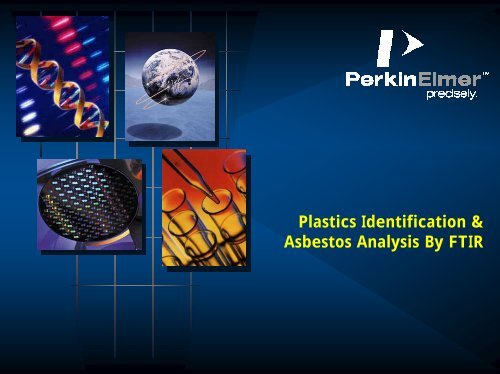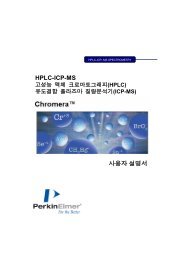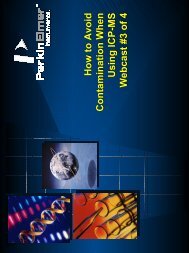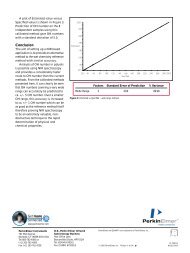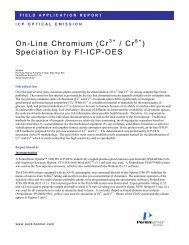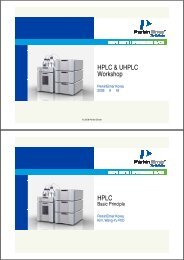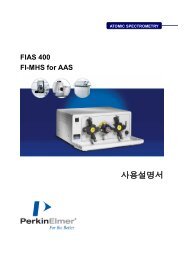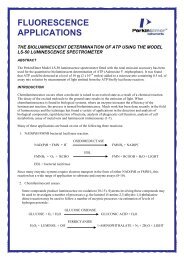Plastics Identification & Asbestos Analysis By FTIR
Plastics Identification & Asbestos Analysis By FTIR
Plastics Identification & Asbestos Analysis By FTIR
You also want an ePaper? Increase the reach of your titles
YUMPU automatically turns print PDFs into web optimized ePapers that Google loves.
<strong>Plastics</strong> <strong>Identification</strong> &<br />
<strong>Asbestos</strong> <strong>Analysis</strong> <strong>By</strong> <strong>FTIR</strong>
Requirements……<br />
…….<br />
‣ Rapid Development in the Electrical and Electronics Industries<br />
‣ Waste generated increased significantly<br />
‣ New materials or chemicals from such waste may be harmful to<br />
humans<br />
‣ In 2003 EU published two directives to control the<br />
disposal of waste and restrict their use from electrical and<br />
electronic equipment<br />
Waste Electronics and Electrical Equipment - WEES<br />
Restriction of the use of certain Hazardous Substance in electrical<br />
and electronic equipment - ROHS 2002/95/EEC<br />
‣ Testing requirements for many materials and chemicals<br />
2 SSB 10.30.02<br />
…..for Testing Dangerous Substances
Requirements……<br />
…….<br />
• Infrared and infrared microscopy an excellent tool for materials<br />
identification and contamination checking.<br />
• <strong>FTIR</strong> technique uses unique fingerprint of materials for<br />
identification and is sensitive and well documented<br />
• Requirements to identify type of plastics in plastic material,<br />
ink,coating, paper, fabric, leather, PCB products using infrared<br />
technique<br />
• Similarly for confirming the contamination of asbestos in<br />
plastics, ink,coating, paper, fabric, leather, PCB products using<br />
infrared and infrared microscopy<br />
3 SSB 10.30.02<br />
…..for Testing Dangerous Substances
Testing limits……<br />
…….<br />
‣ <strong>Identification</strong> of Plastic<br />
‣ Permissible limit : N/A<br />
‣ Source of Legislated Limit : N/A<br />
‣ Possible Method : <strong>FTIR</strong><br />
‣ Test item : Polyvinyl Chloride (PVC)<br />
‣ Chemicals/Compounds : <strong>Asbestos</strong><br />
‣ Permissible Limit : Not detectable<br />
‣ Source of Legislated Limit : 91/659/EEC<br />
‣ Possible method : Microscope/<strong>FTIR</strong>/XRD<br />
‣ Method Used : 83/478/EEC, 85/610/EEC<br />
‣ Criteria/Scope: Chrysotile,crocidolie, amosite, actiolite, anthophyllite,<br />
tremolite<br />
‣ Requirements : All products in this E&E category. Exemption for<br />
chrysotile (under 91/659/EEC), which is a totally banned in a limited<br />
number of products, but still allowed in a component if the products is<br />
labelled according to Annex 2 of 76/769/EEC.According to 99/77/EC C a<br />
total ban, to include chrysotile will be in force by 1-1-2005. 1<br />
‣ Text Reference : 76/769/EEC Annex1, Point 6. Latest version 99/77/EC<br />
7/EC<br />
to be implemented by 2005<br />
4 SSB 10.30.02<br />
…..for Dangerous Substances
Vibrational Spectroscopy<br />
in Polymer <strong>Analysis</strong><br />
Mid-Infrared<br />
– Spectra are well understood - high confidence<br />
– Well supported in the literature<br />
– Good legislative acceptance<br />
– Reliable finger print - good diagnostic tool<br />
– Very versatile technique<br />
– Skilled sample preparation
Infrared Functional Group Table<br />
6 SSB 10.30.02
Infrared Signatures of PVC and additives<br />
PVC RESIN<br />
Semi rigid PVC<br />
DEHP (Di-Ethylhexyl Phthalate)<br />
DINP (Di-Isononyl Phthalate)<br />
7 SSB 10.30.02
Why PVC?<br />
‣Polyvinyl Chloride (PVC, or Vinyl) is one of the most<br />
commonly used materials in the consumer marketplace<br />
‣Found in packaging, construction and automotive material,<br />
all categories of products, including toys, and medical<br />
equipment<br />
‣ PVC contains phthalates, which accumulate in body tissues,<br />
and can damage liver, lungs, and have been shown in lower<br />
mammals to damage reproductive organs<br />
‣Phthalates show almost no toxicity in adult humans even at<br />
high doses, however the cumulative nature of phthalate<br />
toxicity results in toxic effects even at very low dosage when<br />
ingested over a long period of time.<br />
‣ Very young infants may be at greater risk of harm.<br />
‣The common availability of phthalates in the consumer<br />
products causes inevitably chronic ingestion for almost all<br />
modern industrial consumers.<br />
8 SSB 10.30.02
Phthalates<br />
The PVC polymer is a very rigid plastic. When a soft or<br />
flexible plastic is required, a plasticizer is added. Phthalates<br />
esters are the most commonly used in PVC.<br />
DEHP (Di-Ethylhexyl<br />
Phthalate) has been the most commonly<br />
used, and is still used as a plasticizer for all PVC medical<br />
products.<br />
DEHP in children's products was replaced during<br />
the past ten years by DINP (Di-Isononyl<br />
Phthalate)due to<br />
concerns about its toxicity. Semi-rigid PVC contains about 10<br />
percent phthalates; flexible PVC, as much as 50 percent by<br />
weight.<br />
Phthalates migrate easily and are also given off freely by<br />
PVC. DEHP is nearly insoluble in water, but highly soluble in<br />
fats and oils.<br />
When used in medical tubing, it has been found<br />
to accumulate in blood, lung, and liver tissue, as well as in<br />
fat. In fatty foods products packaged in PVC, significant<br />
amounts of DEHP or DINP have been found in surface<br />
layers.<br />
Under relatively slight pressure, phthalates will exude<br />
from PVC. (PVC Handbook, from C. P. Hall, plasticizer<br />
manufacturer).<br />
9 SSB 10.30.02
Polymer analysis<br />
Simplest techniques are<br />
– Film making<br />
– Abrasive pad sampling followed by diffuse<br />
reflectance measurements<br />
– Universal ATR measurement
Film Making<br />
The Process<br />
15-30 minutes<br />
Powder<br />
or<br />
Solid Piece<br />
Heat<br />
+<br />
Pressure<br />
Film<br />
~30um<br />
Cool &<br />
Remove<br />
from press<br />
Spectrometer +<br />
Film Accessory<br />
• High Operational Cost<br />
- High skill<br />
- Not routine handling<br />
- Slow<br />
‣ Process Difficulties<br />
• Sample sticking<br />
• Surface contamination<br />
• Sample degradation<br />
• Interference fringes
Specac Integrated Film Maker<br />
‣ Up to 400 deg C<br />
‣ Water Cooling<br />
‣ 2 tons pressure<br />
‣ Estimated expert<br />
preparation time:<br />
• 15 minutes
Spectrum One - Intelligent Sampling<br />
Diffuse Reflectance<br />
‣ Automatic accessory<br />
recognition<br />
‣ Auto focus to adjust<br />
sample height and on-<br />
screen adjustment<br />
‣ Powder cups,<br />
proprietary coated<br />
abrasive pads, ordinary<br />
uncoated pads, and<br />
diamond sticks<br />
‣ Full multimedia tutorial<br />
13 SSB 10.30.02
Sampling with Abrasive Pad<br />
Particles of sample<br />
Diamond or SiC coated pad
Spectrum One - Intelligent Sampling Drifts<br />
Normally Difficult Samples<br />
Floppy Disk , DRIFT<br />
Abrasive sampling, 8 Scans<br />
K-M<br />
Electrical Connector, In Situ,<br />
DRIFT Abrasive Sampling, 8 Scans<br />
On-screen display of beam<br />
path and accessory<br />
4000.0 3200 2400 1800 1400 1000 400.0<br />
cm-1
Schematic Diamond ATR<br />
Pressure<br />
Sample<br />
Diamond<br />
0<br />
1 mm
The ATR Experiment<br />
SAMPLE<br />
DEPTH OF<br />
PENETRATION<br />
Index n s<br />
θ θ<br />
n c<br />
ATR<br />
CRYSTAL<br />
ELECTRIC<br />
FIELD STRENGTH<br />
MIR<br />
n c<br />
> n s
Advanced Sampling in Mid-IR Diamond ATR<br />
The Process<br />
Powder<br />
or<br />
Solid Piece<br />
Clamp<br />
Optical<br />
Contact<br />
Spectrum<br />
Spectrum One - Intelligent Sampling<br />
Universal ATR<br />
‣ Automatic accessory<br />
recognition<br />
‣ Automatic recognition of<br />
top-plate<br />
plate<br />
‣ On-screen display of force<br />
applied to sample<br />
‣ Diamond crystal<br />
‣ Choice of trough and flat plate<br />
versions<br />
‣ Choice of 1, 3, or 9 reflections<br />
‣ Full multimedia tutorial<br />
19 SSB 10.30.02
Universal ATR – PVC ATR Spectrum<br />
On-screen display of force<br />
applied to sample
Spectrum identification<br />
‣ COMPARE<br />
Simple, intuitive, fast method development,<br />
with unique filters<br />
‣ Euclidean<br />
Search<br />
Full spectrum comparison for large product<br />
libraries<br />
‣ Verify<br />
SIMCA (Soft Independent Modeling by<br />
Class Analogy)<br />
- chemometric approach<br />
- comprehensive statistical information<br />
21 SSB 10.30.02
One approach..<br />
‣ Use 1 reference spectrum per class<br />
‣ Full spectrum comparison<br />
‣ Scores are listed 0-10<br />
‣ Filters designed to minimize influence of common<br />
problems<br />
Compare<br />
22 SSB 10.30.02
Using the Compare algorithm<br />
‣ Simple library development<br />
‣ Intuitive<br />
‣ Filters improve discrimination between similar<br />
materials and improve robustness<br />
‣ Most often the 1st choice for materials verification<br />
N.B<br />
Not easy to include expected sample variability<br />
Filters excellent for emphasising chemical differences,<br />
not always good for physical differences.<br />
23 SSB 10.30.02
Polymer Verification<br />
cm-1
Materials verification using Euclidean Search<br />
‣ Full spectrum comparison for large product libraries<br />
‣ Can use 100’s s of spectra<br />
25 SSB 10.30.02
Euclidean Search for rapid i.d<br />
Spectrum Search<br />
‣ Full spectrum matching<br />
‣ Hits are rated by scores 0-10<br />
‣ Single binary library<br />
‣ Can exclude interferences<br />
26 SSB 10.30.02
Search Results<br />
27 SSB 10.30.02
Why <strong>Asbestos</strong>?<br />
<strong>Asbestos</strong> is a mineral fiber.There are several types of asbestos fibers. In the<br />
past, asbestos was added to a variety of products to strengthen them and to<br />
provide heat insulation and fire resistance.<br />
How Can <strong>Asbestos</strong> Affect My Health?<br />
1) Breathing high levels of asbestos fibers can lead to an increased risk of:<br />
lung cancer<br />
2) mesothelioma, a cancer of the lining of the chest and the abdominal cavity<br />
3) asbestosis, in which the lungs become scarred with fibrous tissue.<br />
The presence of these materials is usually directly or indirectly associated<br />
with the manufacture and production of industrial and consumer products.<br />
The maintenance of legislation to help protect the general public, places a<br />
burden on the analytical chemist to develop simple and reliable methods for<br />
the determination and control of these materials.<br />
A fibre of asbestos or related substance is coated by an iron-protein<br />
complex and surrounded by macrophages - NIOSH<br />
28 SSB 10.30.02
Where is it prohibited?<br />
The placing on the market and the use of products containing<br />
these fibres shall be prohibited for:<br />
(a)toys;<br />
(b)materials or preparations intended to be applied by spraying;<br />
Member States may, however, allow on their territories<br />
butiminous compounds containing asbestos intended to be<br />
applied by spraying as vehicle undersealing for anti-corrosion<br />
protection;<br />
(c)finished products which are retailed to the public in powder<br />
form;<br />
(d)items for smoking such as tobacco pipes and cigarette and<br />
cigar holders;<br />
(e)catalytic filters and insulation devices for incorporation in<br />
catalytic heaters using liquefied gas;<br />
(f)paints and varnishes.'<br />
29 SSB 10.30.02
Classification of asbestos type<br />
‣ <strong>Asbestos</strong> is a collection name to a number of naturally occuring<br />
complex, crystalline,fibrous silicates<br />
ASBESTOS<br />
SERPENTINE<br />
AMPHIBOLE<br />
CHRYSOTILE<br />
CROCIDOLITE AMOSITE ANTHOPHYLLITE TREMOLITE ACTINOLITE<br />
ASBESTOS APPROXIMATE FORMULA<br />
Chrysotile Mg 3 Si 2 O 5 (OH) 4<br />
Amosite<br />
(Fe(II)/Mg) 7 Si 8 O 22 (OH) 2<br />
Anthophyllite<br />
(Mg/Fe(II)) 7 Si 8 O 22 (OH) 2<br />
Crocidolite<br />
Na 2 Fe 3 (II)Fe 2 IIISi 8 O 22 (OH) 2<br />
Tremolite<br />
Ca 2 Mg 5 Si 8 O 22 (OH) 2<br />
30 SSB 10.30.02
<strong>Analysis</strong> of asbestos<br />
Analytical procedure is dependable on the physical<br />
form of the sample and the information required<br />
For confirming the contamination of asbestos in<br />
plastics, ink,coating, paper, fabric, leather, PCB<br />
products using infrared and infrared microscopy<br />
The information we can obtain is characterization<br />
of asbestos type, quantity of asbestos present and/or<br />
relative proportion of individual asbestos types<br />
present in mixed forms.<br />
31 SSB 10.30.02
Analytical techniques for the <strong>Identification</strong><br />
and Control of asbestos<br />
‣Polarized Light Microscopy -P.L.M. is the most<br />
commonly used method for the analysis of bulk samples,<br />
using 450 to 800 power magnification. This method is<br />
performed by dropping acids on samples which results in<br />
a change of color enabling the analyst to determine<br />
percent and the type of asbestos.<br />
PLM of asbestos fibre<br />
‣ Phase Contact Microscopy -P.C.M. is a less expensive method that is<br />
commonly used for the analysis of air samples. During P.C.M., the<br />
sample material is magnified from 450 up to the 800th power.<br />
‣ Transmission Electron Microscopy - T.E.M. analytical method is<br />
100% accurate in either a bulk or air sample -but also very<br />
expensive. The method utilizes an electron microscope,<br />
magnifying the sample material up to 50,000 times.<br />
‣ Infrared Spectrocopy /Microscopy – With careful sample preparation<br />
and in certain cases with computer processing, it is possible to<br />
satisfy the requirements for the different sample categories and to<br />
define well defined IR analytical methodologies.<br />
32 SSB 10.30.02
Spectrum One - Intelligent Sampling<br />
FT-IR Microscope and Imaging Systems<br />
‣ Spotlight - An IR Imaging Tool to<br />
provides the complete picture of<br />
molecular distribution rapidly<br />
‣ AutoIMAGE - Complete PC control of<br />
the microscope with Auto Focus, Auto<br />
Aperture and other automated features<br />
‣ MultiScope - A practical, low-cost tool<br />
for tackling everyday analytical<br />
problems with speed and accuracy<br />
33 SSB 10.30.02
APPLICATIONS OF FT-IR MICROSCOPES<br />
WHAT CAN AN FT-IR MICROSCOPE STUDY?<br />
‣ Small samples down to about 10 x 10 µm m : fibers, , particles,<br />
crystals<br />
‣ Small inhomogenieties in a larger matrix: contaminants in<br />
paper, polymers, electronic components<br />
‣ Surface studies: defects on coatings, painted surfaces<br />
‣ Microscopic changes of composition across a sample:<br />
additives in polymers, purity of materials<br />
‣ And ….<br />
<strong>Asbestos</strong> fibres<br />
34 SSB 10.30.02
Simplified flow diagram of IR peaks of<br />
asbestos<br />
PRESENT<br />
IR BAND AT 775 to 780 cm-1<br />
ABSENT<br />
PRESENT<br />
IR BAND AT 670 cm-1<br />
ABSENT<br />
IR BAND AT 755 cm-1<br />
PRESENT ABSENT<br />
ANTHOPHYLLITE<br />
also at 450, 1015 and 1090 cm-1<br />
BANDS AT 450 cm-1<br />
PRESENT<br />
TREMOLITE<br />
also at 240, 320, 360,<br />
390, 460 and 685 cm-1<br />
ABSENT<br />
CHRYSOTILE<br />
also at 1080, 605, 440,<br />
305 and 3690 cm-1<br />
CROCIDOLITE<br />
also at 1140,1100,<br />
540 and 320 cm-1<br />
AMOSITE<br />
also at 1125,1080,<br />
480 and 428 cm-1<br />
35 SSB 10.30.02
General appearance and interpretation of the<br />
asbestos spectrum<br />
‣ All asbestos exhibit intense absorptions in the 1200-900 cm-1 1 and 600-<br />
300 cm-1 1 regions<br />
‣ Weaker but characteristic bands are observed between 850-600 cm-1.<br />
‣ Maximum information for qualitative identification of asbestos type t<br />
is<br />
gained by recording the spectrum to 200 cm-1<br />
‣ There are weak absorptions around 3700-3200 3200 cm-1 1 and 1700-1400cm<br />
1400cm-1. 1.<br />
‣ Broad absorptions centred around 3400cm-1 1 and 1620 cm-1 1 are due to<br />
absorped water from hygroscopic halide disk matrix.<br />
‣ Chrysotile is significantly different from the amphiboles since it exhibits<br />
an intense double hydroxyl groups at 3693/3648 cm-1 1 produced<br />
between layers of hydroxyl groups sited between the main silicate<br />
layers of the lattice.<br />
‣ This band is used for characterisation and quantitative estimation of the<br />
fibres in samples collected from the dust , or liquids subjected to<br />
asbestos filtration.<br />
‣ This band is sensitive to interference from other mineral silicates such<br />
as talc, kaolinite and montmorillonite which are also used in other<br />
industrial processes<br />
36 SSB 10.30.02
Sample preparation procedure<br />
‣ Selected method is strongly dependent on the type of sample<br />
‣ Using <strong>FTIR</strong> instrument<br />
‣ Airborne samples is deposited on a filter material, ashed and<br />
made into a halide disk prefereably CsI<br />
‣ Groups of fibres in a composite matrix can be prepared as a<br />
CsI/KBr disk.<br />
‣ For resins - removing individual fibres at fracture points in the<br />
sample with tweezers or dissolve the sample with organic<br />
solvent if it is not highly cross-linked and then prepare a CsI disk<br />
‣ Fibres can also be placed on a diamond ATR crystal and<br />
scanned<br />
‣ Using Infrared Microscope – prefereable for individual fibres<br />
‣ Groups of fibres in a composite matrix can be prepared as a<br />
micro CsI/KBr disk with a quick press<br />
‣ Removing individual fibres in the sample with tweezers . Place<br />
sample on a KBr disk and analyse by transmission or place<br />
sample on a gold mirror and analyse by reflection<br />
37 SSB 10.30.02
KBr Disk Sampling
Method for making micro KBr disk<br />
KBr Disks<br />
Quick Press for<br />
micro KBr disk<br />
39 SSB 10.30.02
<strong>Asbestos</strong> spectra<br />
‣ Chrysotile, Amosite, Anthophyllite and Crocidolite forms of<br />
asbestos can be identified individually by infrared spectroscopy<br />
‣ Chrysotile may be determined quantitatively using its absorption<br />
at 3690 cm-1 1 provided anthophyllite is absent<br />
‣ Anthophyllite may be measured using its absorption at 670 cm-1<br />
in the abscence of talc<br />
‣ The absorption bands at 775 cm-1 1 common to amosite,<br />
crocidolite and anthophyllite may be used for quantitatively<br />
analysis of these asbestoses mixed with chrysotile<br />
‣ Many of the other bands in the flow diagram of IR peaks of<br />
asbestos can be used to identify and quantify the different type<br />
of asbestos.<br />
40 SSB 10.30.02
Comparison of Chrysotile and Amphibole<br />
<strong>Asbestos</strong><br />
3690cm-1<br />
1080cm-1<br />
605 cm-1<br />
440 cm-1<br />
305 cm-1<br />
41 SSB 10.30.02
Comparison of Chrysotile,Amosite and<br />
Crocidolite<br />
1125 m-1<br />
1080 cm-1<br />
780 cm-1 Amosite<br />
428cm-1<br />
1140cm-1<br />
780 cm-1<br />
Crocidolite<br />
540cm-1<br />
320cm-1<br />
450cm-1<br />
1100cm-1<br />
42 SSB 10.30.02
Comparison of Chrysotile, Crocidolite,<br />
Anthophylite and Talc<br />
780cm-1<br />
Anthophylite<br />
43 SSB 10.30.02<br />
1090cm-1<br />
1015cm-1<br />
670cm-1<br />
450cm-1
Tremolite<br />
755cm-1<br />
5% Tremolite 20% Tremolite<br />
Frequently asbestoses occur as minor component in a non-asbestos silicate<br />
matrix.A typical example is the amphibole tremolite (and sometimes anthophylite)<br />
which occasionally occurs in similar rock strata as talc. For this reason, batches of<br />
talc are analysed for the possible presence of the amphibole.<br />
44 SSB 10.30.02


